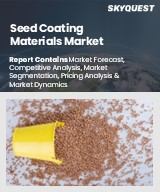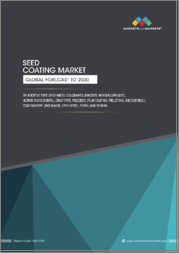
|
시장보고서
상품코드
1572487
종자 코팅 재료 시장 : 기회, 성장 촉진요인, 산업 동향 분석 및 예측(2024-2032년)Seed Coating Material Market, Opportunity, Growth Drivers, Industry Trend Analysis and Forecast, 2024-2032 |
||||||
세계 종자 코팅재 시장은 2023년 약 18억 달러로 평가되었고, 2024년부터 2032년까지 연평균 7.5% 이상 성장할 것으로 예상됩니다.
세계 인구 증가로 식량 생산에 대한 수요가 증가함에 따라 작물 수확량 향상과 식량 안보를 보장하기 위한 노력을 촉구하고 있습니다. 고품질 종자는 더 나은 발아, 더 강한 식물 성장, 농업 생산성 향상을 달성하기 위해 매우 중요합니다. 생산량을 최적화하기 위해 농부들과 농업 관계자들은 고급 종자에 대한 투자를 늘리고 있습니다. 종자 코팅제는 종자를 보호하고 성능을 향상시켜 작물이 환경 스트레스와 질병을 견딜 수 있도록 돕고 궁극적으로 더 탄력적이고 생산적인 수확으로 이어질 수 있도록 중요한 역할을합니다.
성분별 시장 부문에는 바인더, 종자 이식 윤활제, 폴리머, 비료, 착색제, 보조제 등이 있습니다. 폴리머는 2023년 24.6%의 압도적인 시장 점유율을 차지할 것으로 예상되며, 2032년까지 연평균 8.5%의 높은 성장률을 보일 것으로 예상됩니다. 폴리머는 종자 주변에 보호막을 형성하여 종자의 성능과 보호 기능을 강화하여 병충해 및 환경 문제에 대한 저항력을 높입니다. 이 코팅은 심을 때 씨앗의 흐름을 개선하고 비료와 농약과 같은 유효 성분이 균일하게 분포되도록 돕습니다. 폴리머는 다재다능하기 때문에 제조업체는 특정 작물 및 지역 조건에 적합한 제형을 만들 수 있습니다.
시장은 작물 유형에 따라 과일 및 채소, 유지 종자 및 콩류, 기타 작물(잔디 및 관상용 식물 포함)로 구분되며, 2023년 시장 점유율은 곡물 및 곡물이 대부분을 차지할 것으로 예상되며, 2032년까지 연평균 복합 성장률(CAGR)은 6.7%로 예측됩니다. 보리, 밀, 쌀, 옥수수 등 필수 작물에 대한 수요가 많고 재배가 널리 보급되어 있어 곡물 및 곡물 분야가 시장을 장악하고 있습니다. 종자 코팅 재료는 해충, 악조건, 질병으로부터 보호하고 더 나은 작물 성능을 보장하면서 발아율을 높이는 데 중요한 역할을 합니다.
북미는 첨단 농업 기술, 정밀 농업 기술, 연구개발에 대한 막대한 투자로 종자 코팅제 분야에서 선도적인 위치를 차지하고 있습니다. 캐나다와 미국은 농업이 발달하고 종자 처리에 대한 혁신적인 접근 방식을 채택하고 있어 이러한 우위에 크게 기여하고 있습니다. 종자 코팅을 통해 작물 수확량과 품질을 향상시키기 위한 지속적인 노력과 정부의 적극적인 지원은 이 지역의 입지를 더욱 강화시키고 있습니다. 또한, 지속 가능한 농법에 대한 관심이 높아지면서 이 분야에서 북미의 리더십이 더욱 강화되고 있습니다.
목차
제1장 조사 방법과 조사 범위
제2장 주요 요약
제3장 업계 인사이트
- 생태계 분석
- 주요 제조업체
- 유통업체
- 업계 전체 이익률
- 업계에 대한 영향요인
- 성장 촉진요인
- 시장이 해결해야 할 과제
- 시장 기회
- 새로운 기회
- 성장 가능성 분석
- 원재료 상황
- 제조 동향
- 기술 진화
- 원재료의 지속가능성
- 지속가능한 제조
- 그린 프랙티스
- 탈탄소화
- 가격 동향(달러/톤), 2021-2032년
- 규제와 시장에 대한 영향
- Porter's Five Forces 분석
- PESTEL 분석
제4장 경쟁 구도
- 서론
- 기업 매트릭스 분석
- 기업 점유율 분석
- 지역별 기업 점유율 분석
- 북미
- 유럽
- 아시아태평양
- 라틴아메리카
- 중동 및 아프리카
- 지역별 기업 점유율 분석
- 경쟁 포지셔닝 매트릭스
- 전략 대시보드
제5장 시장 규모와 예측 : 성분별, 2021-2032년
- 주요 동향
- 결합제
- 벤토나이트
- 폴리초산비닐(PVA)
- 폴리비닐 피롤리돈(PVP)
- 메틸셀룰로오스
- 스티렌 부타디엔 고무
- 아크릴
- 왁스 또는 왁스 에멀전
- 폴리머
- 폴리머 겔
- 고흡수성 폴리머 겔
- 종자 옮겨심기용 윤활유
- 실리콘
- 탈크
- 흑연
- 기타 파종용 윤활유
- 비료
- 미량영양소 분산제
- 질소 억제제
- 용제
- 항원보강제
- 착색제
제6장 시장 규모와 예측 : 종자 코팅 유형별, 2021-2032년
- 주요 동향
- Film coating
- Encrusting
- Pelleting
제7장 시장 규모와 예측 : 작물 유형별, 2021-2032년
- 주요 동향
- 곡물
- 지방종자 및 콩류
- 과일 및 채소
- 기타 작물(잔디, 관엽식물)
제8장 시장 규모와 예측 : 지역별, 2021-2032년
- 주요 동향
- 북미
- 미국
- 캐나다
- 유럽
- 독일
- 영국
- 프랑스
- 이탈리아
- 스페인
- 아시아태평양
- 중국
- 인도
- 일본
- 한국
- 호주
- 라틴아메리카
- 브라질
- 멕시코
- 아르헨티나
- 중동 및 아프리카
- 사우디아라비아
- 아랍에미리트(UAE)
- 남아프리카공화국
제9장 기업 개요
- BASF SE
- Centor Group
- Clariant International
- Croda International
- FMC Corporation
- Germains Seed Technology
- Incotec Group
- Mahendra Overseas
- Precision Laboratories
- Verdesian Life Sciences
- Xampla
The Global Seed Coating Material Market was valued at approximately USD 1.8 billion in 2023 and is expected to grow at a CAGR of over 7.5% from 2024 to 2032. The rising global population has intensified the demand for food production, prompting efforts to improve crop yields and ensure food security. High-quality seeds are crucial for achieving better germination, stronger plant growth, and increased agricultural productivity. To optimize their output, farmers and agricultural professionals are increasingly investing in premium seeds. Seed coating materials play a vital role by safeguarding seeds and enhancing their performance, helping crops withstand environmental stresses and diseases, ultimately leading to more resilient and productive harvests.
The overall seed coating material industry is classified based on the ingredient, type of seed coating, crop type, and region.
The market segments based on ingredients include binders, seed planting lubricants, polymers, fertilizers, colorants, and adjuvants. Polymers held a dominant market share of 24.6% in 2023 and are expected to grow significantly with a CAGR of 8.5% until 2032. Polymers enhance seed performance and protection by forming a protective coating around seeds, which increases their resistance to pests, diseases, and environmental challenges. This coating improves seed flow during planting and ensures even distribution of active ingredients like fertilizers and pesticides. Due to their versatility, polymers allow manufacturers to create tailored formulations suited to particular crops and regional conditions.
Based on crop type, the market is segmented into fruits and vegetables, oilseeds and pulses, and other crops (including turf and ornamentals). Cereals and grains accounted for a major market share in 2023 and are projected to grow through 2032 at a CAGR of 6.7%. The cereals and grains segment dominates the market, driven by the significant demand and widespread cultivation of essential crops such as barley, wheat, rice, and corn. Seed coating materials play a crucial role in enhancing germination rates while offering protection against pests, adverse environmental conditions, and diseases, ensuring better crop performance.
North America holds a leading position in seed coating materials, driven by cutting-edge farming techniques, precision agriculture technologies, and substantial investment in research and development. Canada and the U.S., with their robust agricultural industries and innovative approaches to seed treatment, are key contributors to this dominance. Ongoing efforts to improve crop yields and quality through seed coatings, alongside favorable government initiatives, further strengthen the region's standing. Additionally, the growing focus on sustainable farming practices reinforces North America's leadership in this sector.
Table of Contents
Chapter 1 Methodology and Scope
- 1.1 Market scope and definition
- 1.2 Base estimates and calculations
- 1.3 Forecast calculation
- 1.4 Data sources
- 1.4.1 Primary
- 1.4.2 Secondary
- 1.4.2.1 Paid sources
- 1.4.2.2 Public sources
Chapter 2 Executive Summary
- 2.1 Industry 360° synopsis
Chapter 3 Industry Insights
- 3.1 Industry ecosystem analysis
- 3.1.1 Key manufacturers
- 3.1.2 Distributors
- 3.1.3 Profit margins across the industry
- 3.2 Industry impact forces
- 3.2.1 Growth drivers
- 3.2.2 Market challenges
- 3.2.3 Market opportunity
- 3.2.3.1 New opportunities
- 3.2.3.2 Growth potential analysis
- 3.3 Raw material landscape
- 3.3.1.1 Manufacturing trends
- 3.3.1.2 Technology evolution
- 3.3.1.3 Sustainability in raw materials
- 3.4 Sustainable manufacturing
- 3.4.1.1 Green practices
- 3.4.1.2 Decarbonization
- 3.5 Pricing trends (USD/Ton), 2021 to 2032
- 3.5.1.1 North America
- 3.5.1.2 Europe
- 3.5.1.3 Asia Pacific
- 3.5.1.4 Latin America
- 3.5.1.5 Middle East and Africa
- 3.6 Regulations and market impact
- 3.7 Porter's analysis
- 3.8 PESTEL analysis
Chapter 4 Competitive Landscape, 2023
- 4.1 Introduction
- 4.2 Company matrix analysis
- 4.3 Company market share analysis
- 4.3.1 Company market share analysis by region
- 4.3.1.1 North America
- 4.3.1.2 Europe
- 4.3.1.3 Asia Pacific
- 4.3.1.4 Latin America
- 4.3.1.5 Middle East Africa
- 4.3.1 Company market share analysis by region
- 4.4 Competitive positioning matrix
- 4.5 Strategic dashboard
Chapter 5 Market Size and Forecast, By Ingredient, 2021-2032 (USD Billion, Kilo Tons)
- 5.1 Key trends
- 5.2 Binders
- 5.2.1 Bentonite
- 5.2.2 Polyvinyl acetate (PVA)
- 5.2.3 Polyvinylpyrrolidone (PVP)
- 5.2.4 Methyl cellulose
- 5.2.5 Styrene butadiene rubber
- 5.2.6 Acrylics
- 5.2.7 Waxes or wax emulsions
- 5.3 Polymers
- 5.3.1 Polymer gels
- 5.3.2 Super absorbent polymer gels
- 5.4 Seed planting lubricants
- 5.4.1 Silicon
- 5.4.2 Talc
- 5.4.3 Graphite
- 5.4.4 Other seed planting lubricants
- 5.5 Fertilizers
- 5.5.1 Micro-nutrient dispersant
- 5.5.2 Nitrogen inhibitor
- 5.5.3 Solvents
- 5.6 Adjuvants
- 5.7 Colorants
Chapter 6 Market Size and Forecast, By Type of Seed Coating, 2021-2032 (USD Billion, Kilo Tons)
- 6.1 Key trends
- 6.2 Film coating
- 6.3 Encrusting
- 6.4 Pelleting
Chapter 7 Market Size and Forecast, By Crop Type, 2021-2032 (USD Billion, Kilo Tons)
- 7.1 Key trends
- 7.2 Cereals and grains
- 7.3 Oilseeds and pulses
- 7.4 Fruits and vegetables
- 7.5 Other crops (turf, ornamentals)
Chapter 8 Market Size and Forecast, By Region, 2021-2032 (USD Billion, Kilo Tons)
- 8.1 Key trends
- 8.2 North America
- 8.2.1 U.S.
- 8.2.2 Canada
- 8.3 Europe
- 8.3.1 Germany
- 8.3.2 UK
- 8.3.3 France
- 8.3.4 Italy
- 8.3.5 Spain
- 8.4 Asia Pacific
- 8.4.1 China
- 8.4.2 India
- 8.4.3 Japan
- 8.4.4 South Korea
- 8.4.5 Australia
- 8.5 Latin America
- 8.5.1 Brazil
- 8.5.2 Mexico
- 8.5.3 Argentina
- 8.6 MEA
- 8.6.1 Saudi Arabia
- 8.6.2 UAE
- 8.6.3 South Africa
Chapter 9 Company Profiles
- 9.1 BASF SE
- 9.2 Centor Group
- 9.3 Clariant International
- 9.4 Croda International
- 9.5 FMC Corporation
- 9.6 Germains Seed Technology
- 9.7 Incotec Group
- 9.8 Mahendra Overseas
- 9.9 Precision Laboratories
- 9.10 Verdesian Life Sciences
- 9.11 Xampla
















